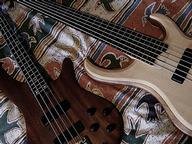
Check Out Guitar George, He Knows All the Chords Quiz
Great Rock Guitar Solos
Inspired by a line in Dire Straits' "Sultans of Swing", here is a quiz dedicated to ten of the greatest guitar solos in classic rock and the guitarists behind them. Can you match the guitarist (or guitarists) with the song in which the solo appears?
A matching quiz
by LadyNym.
Estimated time: 3 mins.